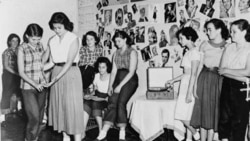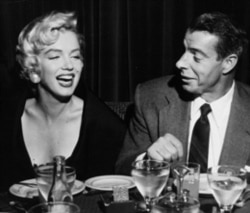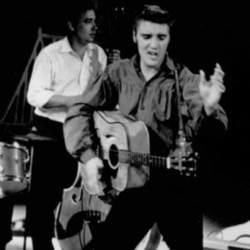STEVE EMBER: Welcome to THE MAKING OF A NATION – American history in VOA Special English. I’m Steve Ember.
Imagine a time machine. You’ve just climbed into it for the purpose of visiting the United States – in the nineteen-fifties.
What would you expect to find?
In the nineteen fifties, America was a nation whose population was growing as never before. It was a nation where the popular culture of television was both reflecting and influencing its lifestyle.
(MUSIC)
But it was also a nation that believed it was on the edge of nuclear war.
Americans were happy to put World War Two behind them. The war ended in nineteen forty-five. People were hopeful. They thought the world would be peaceful for a while.
By nineteen fifty, however, political tensions were high again.
The United States and the Soviet Union were allies in World War Two. But, after the war, they became enemies in what came to be known as the Cold War.
Communists took control of one eastern European nation after another. The Soviet Union led by Josef Stalin strengthened its armed forces. However, the United States thought America alone possessed the most powerful weapon of all -- the atomic bomb.
(MUSIC)
But in nineteen forty-nine, a United States Air Force plane discovered strange conditions in the atmosphere. What was causing them?
The answer came quickly: the Soviet Union had tested its own atomic bomb.
The nuclear race was on. The two nations competed to build weapons of mass destruction.
A "doomsday clock" on the cover of the Bulletin of the Atomic Scientists warned of a growing danger of nuclear destruction. Members of that group were afraid of what science had produced, and even more afraid of what it could produce.
By nineteen forty-nine, the time on the doomsday clock was three minutes to midnight.
(SOUND)
In nineteen fifty, North Korea invaded South Korea. The Korean war increased efforts in the United States to develop a weapon even more deadly than the atomic bomb. That weapon was the hydrogen bomb.
The Soviets were also working to develop their own hydrogen bomb.
Some Americans built bomb shelters in their backyards, hoping to have a safe place for their families in case of a nuclear attack.
Other Americans, however, were tired of being afraid. After years of sacrifice, they wanted to enjoy the good life in a growing economy.
Nineteen fifty-two was a presidential election year. Americans elected Dwight Eisenhower, a military hero of World War Two.
The years after the war produced the Baby Boom generation. In nineteen fifty there were twenty-four million young children in America. By nineteen sixty that number was thirty-five million.
More families meant the need for more houses. And bigger families needed bigger houses. In nineteen fifty alone, almost one and a half million new homes were built in America.
Most of these new houses were located in suburbs, the areas outside cities. People moved to the suburbs because they thought the schools there were better than city schools. They also liked having more space for their children to play in.
(SOUND)
More space meant children had room to lay out electric train sets. In a lot of American homes, playing with electric trains was an activity that brought the whole family together.
Television ads for Lionel trains even featured baseball great Joe DiMaggio.
TV ANNOUNCER: “Lionel Trains proudly present The Joe DiMaggio Show, starring the Yankee Clipper, Joe DiMaggio himself”
The late nineteen fifties brought the Barbie doll and a big circular tube of colorful plastic called the Hula Hoop. People had to learn to move their hips in a circular motion, like a hula dancer in Hawaii, to spin it around their body.
Also popular was the poodle cut -- not for dogs, but for women who wanted to look stylish. They fixed their hair into lots of small curls, like the hair on a poodle.
Actress Mary Martin had made the poodle cut famous in the musical "South Pacific." That play opened on Broadway in New York in nineteen forty-nine.
(MUSIC: “Diamonds Are a Girl’s Best Friend”)
In Hollywood, one of the biggest movie stars of the nineteen fifties was Marilyn Monroe. She starred in films like "Gentleman Prefer Blondes" in nineteen fifty-three. Her platinum-blonde hair style also became popular among American women.
JAMES DEAN in “Rebel Without A Cause”: “I woke up this morning, you know, and the sun was shining. And it was nice, and all that type of stuff. And the first thing, I saw you, and I said, now, boy this is gonna be one terrific day…”
Another famous actor was James Dean, best known for the nineteen fifty-five movie "Rebel Without a Cause." That same year he died in a car accident at the age of twenty-four.
In literature, there were writers and poets who came to be known as the Beat generation. These included Jack Kerouac, Gregory Corso and Allen Ginsberg. To them, much of life in nineteen-fifties America was empty and meaningless.
The painter Jackson Pollock represented a spirit of rebellion in art. Pollock would drop paint onto a canvas. What did his works mean? People had to decide for themselves.
(MUSIC: “Don’t Be Cruel”)
In music, the rebel was Elvis Presley -- the king of rock and roll.
Elvis Presley was a twenty-one-year-old truck driver when he sang on television for the first time.
Some parents and religious leaders thought he was a bad influence. They thought the way he moved his body to the music was too suggestive. But young people screamed for more. They listened to Elvis' music on records, on the radio and on the television program "American Bandstand."
(MUSIC)
"American Bandstand" became the most popular dance party in America. Every week, young people danced to the latest songs in front of the TV cameras.
(MUSIC)
But it wasn’t all rock and roll. Whether on Bandstand-type television programs or at local “record hops,” or at home, young Americans – and their parents – danced cheek to cheek to romantic ballads as well.
Television in the nineteen-fifties included dramas acted live on TV.
And there were quiz shows, and game shows, and comedy programs.
(MUSIC)
If Elvis was the king of rock and roll, Lucille Ball was the queen of comedy. During the nineteen fifties, millions of Americans watched "I Love Lucy." Lucille Ball starred with her husband Desi Arnaz. They played Lucy and Ricky Ricardo. Ricky is a Cuban bandleader in New York. Lucy is a housewife who wishes she could be famous like her husband.
LUCY: "What will I have to do?"
RICKY: "You gonna have to get me back on the television show."
LUCY: "How?"
RICKY: "I don’t know how. But, if you don't, I'll ... "
LUCY: "I will, Ricky. I’ll get you back on the show. Don’t even think of what you’ll do if I don't [imitating Ricky's Cuban accent]."
Lucille Ball and "I Love Lucy" were both big influences on generations of entertainers and TV comedy producers.
Variety shows offered a mix of entertainment. Americans watched shows hosted by comics like Milton Berle, Jackie Gleason and Sid Caesar.
Ed Sullivan was not a comedian, but for years his show brought new acts into American homes every Sunday night.
Television shows were all in black-and-white. But one night in nineteen fifty-three, Americans got their own time-machine glimpse into the future of TV. It happened with an announcement during Sid Caesar’s “Your Show of Shows."
NBC TV NEWSMAN: “This is Richard Harkness in Washington. This week will long be remembered in the annals of television, for on Thursday, December seventeenth, the Federal Communications Commission approved Compatible Color Television.”
That meant that owners of TV sets could still watch programs broadcast in color -- in black and white -- instead of having to buy a new set. Color TV's popularity grew quickly, and the prices of color TVs came down, meaning more color TVs in American homes, and more and more programs produced in color.
TV ANNOUNCER: “The following program is brought to you in living color on NBC.”
During the nineteen fifties, most of the people who appeared on television were white. If black actors appeared, they were usually in jobs working for white people.
But in real life, a civil rights movement was beginning to gather strength. Legal battles were fought to end racial separation, especially in public schools.
In nineteen fifty-four, the United States Supreme Court made a historic ruling. The case was known as Brown v. Board of Education. The court ruled that the requirement in some states for racially separate schools was unconstitutional. The court rejected the idea that schools for black students could be "separate but equal" to those attended by white students.
By the nineteen sixties, the civil rights movement would shake American society.
Dwight Eisenhower was president for most of the nineteen fifties. He faced the problems of communism, nuclear threats and racial tensions. "Ike" had a calm way of speaking to the public. Many Americans saw him as a fatherly president. They thought that even in a dark and dangerous world, everything would be all right.
Were they correct? We'll try to answer that in future programs.
You can find our series online with transcripts, MP3s, podcasts and pictures at voaspecialenglish.com. And you can follow us on Facebook and Twitter at VOA Learning English. I’m Steve Ember, inviting you to join us again next week for THE MAKING OF A NATION -- American history in VOA Special English.
___
Contributing: Jerilyn Watson
This was program #206. For earlier programs, type "Making of a Nation" in quotation marks in the search box at the top of the page.







